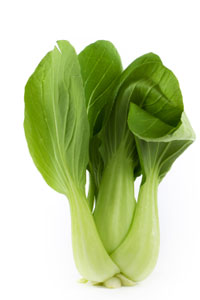Before the name makes you run in fear, hear us out. Bok choy is a nutritious little cruciferous vegetable that deserves a second look, and an addition to your favorite meals. It takes on the flavors of just about any dish and is also incredibly healthy. Consider this your bok-choy guide, and be sure to check out the tasty recipes at the end of the post to give this tasty veggie a go.
What is bok choy? Bok choy is a leafy Chinese cabbage that’s especially common in China, the Phillipines, and Vietnam. But it’s also become popular in other regions and stateside as well. It’s of the brassica family and is known for its sweet, nutrition-packed stalks. Bok choy can resemble collards and even cabbage, and grows upright from the ground. It’s also commonly referred to pak choi, pet say, white celery mustard, or Chinese white cabbage.
Health benefits: While bok choy is low in calories, it’s incredibly high in vitamins A, C, and K, as well as folate and vitamin B6. It also contains several carotenoids, including beta carotene which is extremely beneficial for eye health. Bok choy is also high in dietary fiber, low in sodium and a good source of calcium and potassium.
Nuritional stats: One cup of shredded bok choy contains approximately 20 calories, 0 grams of fat, 3 grams of carbohydrates, 2 grams of fiber, 1 gram of sugar, and 3 grams of protein.
Cooking methods: When selecting bok choy, look for stalks that are firm and have no brown spots. The leaves should be green with no signs of discoloration or wilting. It’s recommended to wash bok choy thoroughly since dirt can easily hide inside. To prep bok choy, pull the stalks from the base then trim an inch or so from the root. Although the entire stem and leaf can be cooked together, the stalk can take longer to cook, which is why removing the leaves and adding them in at the very end is sometimes preferred.
Once prepped, bok choy can be cooked a number of different ways. Add it to soups, sear in stir fries, wilt and add to noodle dishes, toss in olive oil and roast, or add it uncooked to salads. This versatile veggie can be enjoyed just about any way you can imagine.
Recipes:
Baby Bok Choy and Beef Noodle Soup
Stir Fried Bok Choy with Ginger and Garlic
Steamed Bok Choy with Ume Vinagrette
Consider yourself an official student of all-things bok choy. Now go forth and make delicious – and healthy – meals with this versatile new veggie. This could be one of the 10 ways you revolutionize your food.
